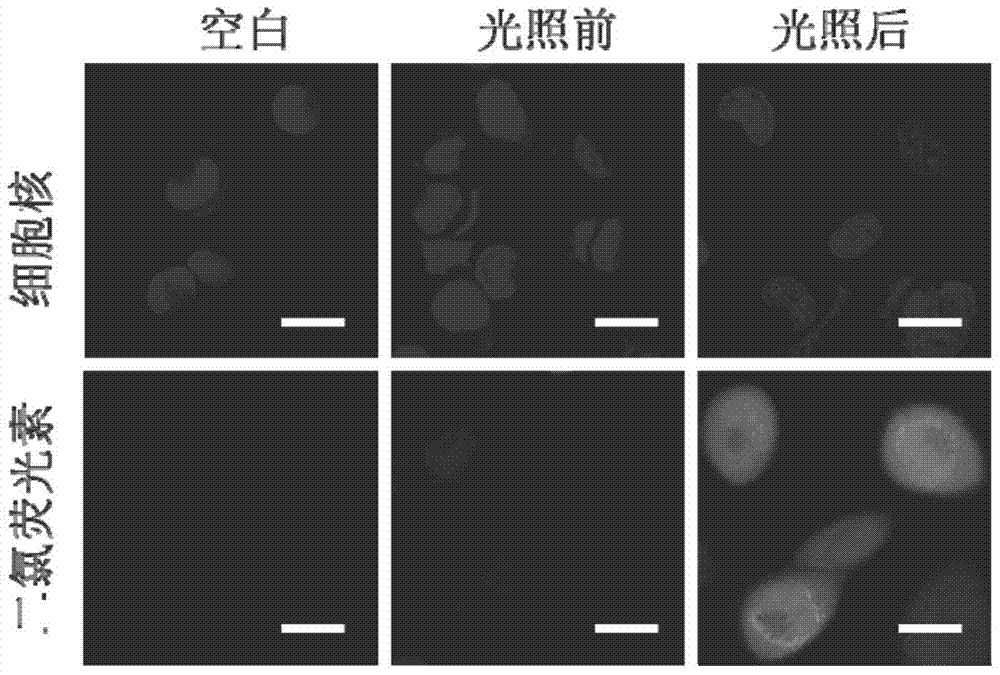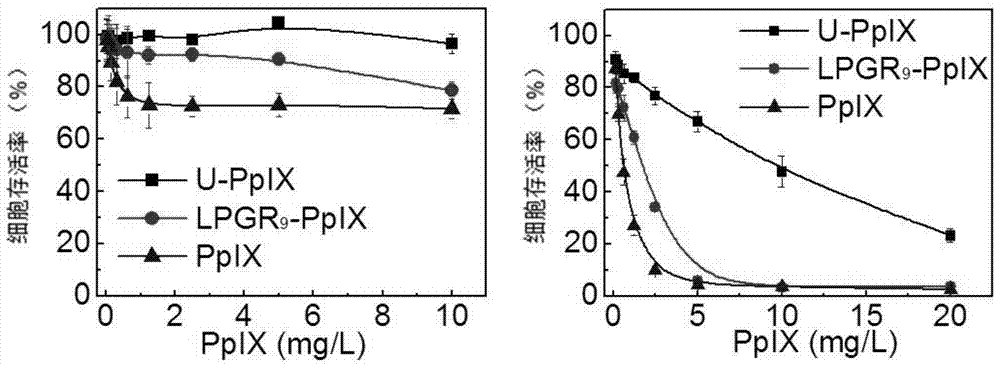A tumor-targeting polypeptide photosensitizer bond
A peptide photosensitizer and tumor-targeting technology, which is applied in the field of biomedicine, can solve the problems of ineffective enrichment and achieve targeted enrichment, transmembrane delivery, and simple preparation methods
- Summary
- Abstract
- Description
- Claims
- Application Information
AI Technical Summary
Problems solved by technology
Method used
Image
Examples
Embodiment 1
[0029] Positively charged polypeptide photosensitizer bond (protoporphyrin-arginine-arginine-arginine-arginine-arginine-arginine-arginine-arginine-arginine -Glycine-Proline-Leucine, LPGR 9 -PpIX) Synthesis:
[0030] (1) Add 0.5 g of 2-chloro-trityl chloride resin (1.05 mmol / g) to a reactor containing 10 mL of re-evaporated N,N-dimethylformamide, and wait until 2-chloro-trityl chloride The benzyl chloride resin was swelled in N,N-dimethylformamide for 2h and then the N,N-dimethylformamide was removed.
[0031] (2) Dissolve FMOC-protected leucine (4 times the equivalent of the active site of the resin) and N,N-diisopropylethylamine (4 times the equivalent of the amino acid) in 10 mL of N,N-dimethylformamide Then add it to the reactor to react at room temperature for 2h to bond leucine to the resin, remove the solvent, and wash with N,N-dimethylformamide for 2 to 4 times.
[0032] (3) Add 10 mL of methanol / N,N-dimethylformamide / N,N-diisopropylethylamine in the ratio of 1:7:2 (V / V / V) i...
Embodiment 2
[0040] Positively charged [Arginine] 9 Polypeptide (cell penetrating peptide), negatively charged [glutamate] 8 Peptides and matrix metalloproteinases specifically recognize the photosensitizer bond of the polypeptide proline-leucine-glycine-leucine-alanine-glycine (protoporphyrin-arginine-arginine-arginine) -Arginine-arginine-arginine-arginine-arginine-arginine-glycine-proline-leucine-glycine-leucine-alanine-glycine-glutamic acid -Glutamate-glutamate-glutamate-glutamate-glutamate-glutamate-glutamate, U-PpIX) synthesis:
[0041] (1) Add 0.5 g of 2-chloro-trityl chloride resin (1.05 mmol / g) to a reactor containing 10 mL of re-steamed N,N-dimethylformamide, and wait until 2-chloro-trityl chloride The benzyl chloride resin was swelled in N,N-dimethylformamide for 2h and then the N,N-dimethylformamide was removed.
[0042] (2) The first amino acid is bonded to the resin: FMOC-protected glutamic acid (4 times equivalent of the active site of the resin) and N,N-diisopropylethylamine (4 ...
Embodiment 3
[0052] Human fibrosarcoma (HT 1080) cells are 1×10 5 The density of each cell / well was seeded in a 6-well plate and cultured in 1 mL of RPMI-1640 medium at 37°C. After 24h, add 1 mL of PpIX and LPGR dissolved in the culture medium equivalent to the concentration of 10mg / L PpIX into each well of the 6-well plate. 9 -PpIX, U-PpIX, and a blank control (add 1mL medium). After 1h of endocytosis, the PpIX and LPGR in the wells 9 -PpIX or U-PpIX is washed clean, and then digested with 0.25% trypsin for 1 min. Centrifuge at low speed, wash the cells three times with PBS, and finally redisperse the cells in 0.3mL PBS. Use flow cytometry to measure the PpIX or PpIX bond in the cells. Flowjo 7.6 software measures the PpIX or PpIX in the cells. The PpIX bond is quantitatively analyzed.
[0053] See the result figure 1 : LPGR containing positively charged peptides 9 -PpIX bond can enhance the endocytosis of protoporphyrin in HT 1080 cells; for HT 1080 cells with overexpression of matrix meta...
PUM
 Login to View More
Login to View More Abstract
Description
Claims
Application Information
 Login to View More
Login to View More - Generate Ideas
- Intellectual Property
- Life Sciences
- Materials
- Tech Scout
- Unparalleled Data Quality
- Higher Quality Content
- 60% Fewer Hallucinations
Browse by: Latest US Patents, China's latest patents, Technical Efficacy Thesaurus, Application Domain, Technology Topic, Popular Technical Reports.
© 2025 PatSnap. All rights reserved.Legal|Privacy policy|Modern Slavery Act Transparency Statement|Sitemap|About US| Contact US: help@patsnap.com



